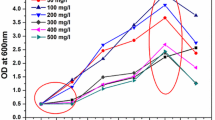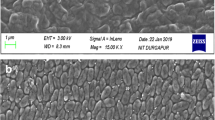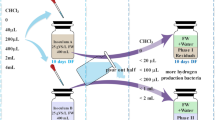Abstract
Methyl iso-butyl ketone (MIBK) is a widely used volatile organic compound (VOC) which is highly toxic in nature and has significant adverse effects on human beings. The present study deals with the removal of MIBK using biodegradation by an acclimated mixed culture developed from activated sludge. The biodegradation of MIBK is studied for an initial MIBK concentration ranging from 200–700 mg l−1 in a batch mode of operation. The maximum specific growth rate achieved is 0.128 h−1 at 600 mg l−1of initial MIBK concentration. The kinetic parameters are estimated using five growth kinetic models for biodegradation of organic compounds available in the literature. The experimental data found to fit well with the Luong model (R 2 = 0.904) as compared to Haldane model (R 2 = 0.702) and Edward model (R 2 = 0.786). The coefficient of determination (R 2) obtained for the other two models, Monod and Powell models are 0.497 and 0.533, respectively. The biodegradation rate found to follow the three-half-order kinetics and the resulting kinetic parameters are reported.





Similar content being viewed by others
References
Andrews JF (1968) A mathematical model for the continuous culture of microorganisms utilizing inhibitory substance. Biotechnol Bioeng 10:707–723
Babu BV, Raghuvanshi S (2004) Biofiltration for VOC removal: a state-of-the-art review. In: Proceedings of international symposium & 57th annual session of IIChE in association with AIChE (CHEMCON-2004), December 27–30, 2004. India Institute of Chemical Engineers, Mumbai
Bridie AL, Wolff M, Winter CJM (1979) BOD and COD of some petrochemicals. Water Res 13:627–630
Brunner W, Focht DD (1984) Deterministic three-half order kinetic model for microbial degradation of added carbon substrates in soil. Appl Environ Microbiol 47:1211–1216
Dapena-Mora A, Fern′andez I, Camposa JL, Mosquera-Corral A, M′endez R, Jetten MSM (2007) Evaluation of activity and inhibition effects on Anammox process by batch tests based on the nitrogen gas production. Enzyme Microb Technol 40:859–865
Deshusses MA (1994) Biodegradation of mixtures of ketone vapours in biofilters for the treatment of waste air. Ph D Thesis, Swiss Federal Institute of Technology, Zurich, Switzerland
Deshusses MA, Hamer G, Dunn IJ (1995) Transient state behavior of a biofilter removing mixtures of vapors of MEK and MIBK from air. Biotechnol Bioeng 49:587–598
Devinny SJ, Deshusses MA, Webster ST (1999) Biofiltration for air pollution control, 1st edn. Lewis Publishers, New York
Edwards VH (1970) The influence of high substrate concentrations on microbial kinetics. Biotechnol Bioeng 12:679–712
Larson RJ (1980) Role of biodegradation kinetics in predicting environmental fate. In: Maiki AW, Dickson KL, Cairns J Jr (eds) Biotransformation and the fate of chemicals in the aquatic environment. American Society for Microbiology, Washington, DC, pp 67–86
Luong JHT (1986) Generalization of monod kinetics for analysis of growth data with substrate inhibition. Biotechnol Bioeng 29:242–248
Mitchell JW (1992) Alternative starting materials for industrial processes. Proc Natl Acad Sci 89:821–826
Monod J (1949) The growth of bacterial cultures. Annu Rev Microbiol 3:371–394
Okpokwasili GC, Nweke CO (2005) Microbial growth and substrate utilization kinetics. African J Biotechnol 5:305–317
OSHA (1989) Air contaminants, health effects discussion and determination of final PEL, section VI, Amended final rule, Occupational Safety and Health Administration, Washington, USA, January 1989
Paris DF, Steen WC, Baughman GL, Barnett JT Jr (1981) Second-order model to predict microbial degradation of organic compounds in natural waters. Appl Environ Microbiol 41:603–609
Peyton BM, Wilson T, Yonge DR (2002) Kinetics of phenol biodegradation in high salt solutions. Water Res 36:4811–4820
Powell EO (1967) The growth rate of microorganisms as function of substrate concentration. Microbial physiology and continuous culture. Evans CGT, Strange RE, Tempest W Edition, HMSO, London, United Kingdom
Price KS, Waggy GT, Conway RA (1974) Brine shrimp bioassay and seawater BOD of petrochemicals. J Water Pollut Control Fed 46:63–77
Quesnel D, Nakhla G (2006) Removal kinetics of acetone and MIBK from a complex industrial wastewater by an acclimated activated sludge. J Hazard Mater B132:253–260
Raghuvanshi S, Babu BV (2009) Experimental studies and kinetic modeling for removal of methyl ethyl ketone using biofiltration. Bioresour Technol 100:3855–3861
Rene ER, Murthy DVS, Swaminathan T (2005) Performance evaluation of a compost biofilter treating toluene vapours. Process Biochem 40:2771–2779
Robinson JA, Tiedje JM (1983) Non linear estimation of monod growth kinetic parameters from a single substrate depletion curve. Appl Environ Microbiol 45:1453–1458
Saravanan P, Pakshirajan K, Saha P (2008) Growth kinetics of an indigenous mixed microbial consortium during phenol degradation in a batch reactor. Bioresour Technol 99:205–209
Sokol W (1986) Oxidation of an inhibitory substrate by washed cells (oxidation of phenol by Pseudomonas putida). Biotechnol Bioeng 30:921–927
Tang WT, Fan LS (1987) Steady state phenol degradation in a draft tube gas-liquid-solid fluidized bed bioreactor. AIChE J 33:239–249
Tomei MC, Annesini MC, Bussoletti S (2004) 4-Nitrophenol biodegradation in a sequencing batch reactor: kinetic study and effect of filling time. Water Res 38:375–384
WHO (1990) Methyl isobutyl ketone. Environmental health criteria 117. World Health Organization, Geneva, p 79
WHO (1993) Methyl ethyl ketone. Environmental health criteria 143. World Health Organization, Geneva, Switzerland, p 161
Acknowledgments
Authors thank the University Grants Commission (UGC), New Delhi, India for their financial support.
Author information
Authors and Affiliations
Corresponding author
Rights and permissions
About this article
Cite this article
Raghuvanshi, S., Babu, B.V. Biodegradation kinetics of methyl iso-butyl ketone by acclimated mixed culture. Biodegradation 21, 31–42 (2010). https://doi.org/10.1007/s10532-009-9279-6
Received:
Accepted:
Published:
Issue Date:
DOI: https://doi.org/10.1007/s10532-009-9279-6




